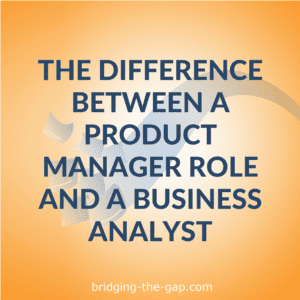 The product manager role and business analyst role go hand in hand. Many product managers get their start as business analysts, and as a product manager, you can expect to work closely with a business analyst.
The product manager role and business analyst role go hand in hand. Many product managers get their start as business analysts, and as a product manager, you can expect to work closely with a business analyst.
What’s the difference between the two roles? And how do you transition from one role to another?
That’s the question we address in today’s video.
For those who like to read instead of watch, here’s the full text of the video:
Hey there, this is Laura Brandenburg from Bridging the Gap, and we help business analysts get started in their careers.
We’ve been receiving a lot of questions about the difference between product manager roles and business analyst roles, how they work together, and how you can move between these different roles as you plan out your career, so I decided to chat about that today.
Before we jump into how they work together, let’s talk about what each role is.
Product Manager Role
A product manager, you could think of as the CEO of the product. They just own the product. The own the strategy. They own the roadmap. They own the future definition of what is that product going to do. Sometimes they’re also in charge of the marketing, coordinating with the sales team, maybe forecasting, and have overall profit and loss (or P&L), responsibilities for their product, or for an entire product line with an organization.
Business Analyst Role
The definition of business analysis from the International Institute of Business Analysis™ (IIBA®), is that it’s
“the practice of enabling change in the organization by defining needs and recommending solutions.”
Often, when that change involves software, then the business analyst is collaborating and facilitating a discussion and requirements between business and the technology team. So, it’s the business team that is desiring the software or business change, and the software team that is enabling that by delivering a software solution.
And they’re in the middle of collaborating and making sure everybody is on the same page about the requirements and what that updated business process will be. That could include business process definition, a functional requirements definition, and data requirements definition.
How Product Managers and Business Analysts Work Together
When that change or that software involves a new product, then, often, that business owner is actually the product manager. And, so, the business analyst is coordinating and collaborating with the product manager and making sure the requirements are understood and defined so that the software team can build against those requirements.
I actually got my start as a business analyst in the product space, or the product world, so, I want to share a couple of examples from my career.
Product Management + Business Analysis on an eBook Platform
My very first project, or company that I worked for, they were an online publishing company. The first product I got to work on was an eBook platform. I was the business analyst. We were mostly focused on the software changes – the software features and functions, the functional requirements for that eBook platform. I worked with a product manager who owned that platform.
Just like we talked about, she had the profit and loss responsibilities. It was coordinating with the sales team for the rollout, coordinating with marketing for the marketing plan, and she owned what that software needed to do in order for it to achieve its financial objectives for the company.
An interesting part of my role though that developed ̶ she was in charge of the customer-facing features, but there were a lot of features that we had to put in place to successfully serve our customers and fulfill our customers.
I ended up, as the business analyst, taking more of a leadership role in the internal part of the product, working with somebody from customer service and fulfillment to define what their needs would be and make sure that those requirements were covered as well, so that we could serve not only our customers, and not have just those customer-facing features, but make sure our business processes are and our internal products were in place to make sure that the product could be a success.
(Want to learn more about business processes? Go here to download my free business process template.)
Quite a few of my experiences throughout my early days as a business analyst were very similar. I was working on a lot of online content, a lot of online publishing companies, and we were doing similar kinds of products in that my role was very similar in all of those.
Product Management + Business Analysis to Build a Website for Customer-Facing Processes
Then I started working as a contractor for another organization that was taking their internally focused business process and getting that online. It was, essentially, another way of creating a product.
They were enabling, through a website, to have their customers interact with them through a website where it was, previously, they were faxing in information and calling. I don’t even think they used a lot of email ̶ a lot of phone and a lot of fax, some email. We were putting that business process onto a website and enabling the end user, the customer, to collaborate with the company through the website.
In a way, that was another product. I wasn’t really a product manager in that one, interestingly. There was a project manager who was a business subject matter expert. They filled the role, essentially, of product manager, as well.
The Product Manager Role Has More Decision-Making Power
The biggest difference, if you look at some of these examples, is that the product manager has more decision-making power.
- They’re deciding what the software should do.
- They’re often collaborating up with executive teams to make sure that the product is aligned with the bigger picture organizational objectives.
- They might have some true financial responsibilities for the company as well.
The business analyst is more of the facilitator role discovering the requirements from the product manager who might be collaborating with end users, hopefully, figuring out what the customer wants, and bringing that information into the business analyst.
Sometimes the business analyst and product manager will do that together. As a business analyst on a product, I would get to sit into some of those end-user sessions, or the discovery sessions that the product manager was doing with actual representative customers as well. I was hearing firsthand what those needs were from the customers.
My role was taking that information, making sure that I understood what the product owners’ priorities were based on that information, and then defining, and detailing out the requirements and collaborating with technology to make sure that those requirements could get implemented.
Product Management and Business Analysis Career Paths
Because of this, many business analysts see product management as a logical step forward in their careers. It does. It involves more authority, more decision-making power, probably advanced salaries as well. You could look at it as a promotion. But if you are a product manager, you’re probably going to be working with business analysts. It’s worthwhile to know a little bit about business analysis as well. Here’s a list of key business analysis skills to get you started.
If your ultimate goal is to be a product manager, I think there can be, unless you have a lot of prior professional experience, it can be a pretty rough role to just jump right into right away. You could be looking at business analysis as an interim career path on your way to product management.
Because business analysis is going to be a great way to build a lot of those communication skills, to understand what a product is, to work with a project team, and to start building those leadership skills, as well, that you’re going to need at even more advanced levels as a product manager.
Again, I’m Laura Brandenburg at Bridging the Gap. At Bridging the Gap, we help business analysts start their careers. We’ve got lots of great resources for you if you do want to pursue a career in business analysis. Be sure to check out our website.
Until next time, great to be here, and I’ll chat soon. Thank you.
Learn More About Business Analysis

This book will help you find your best path forward into a business analyst career. More than that, you will know exactly what to do next to expand your business analysis opportunities.
Click here to learn more about How to Start a Business Analyst Career
